Social Security
One man's systematic approach
to building a healthy society -- molded from an idea
as old as mankind -- may be the one thing that can bring
us all together.
By
Nancy Bartosek
 Mack McCarter
'67 (MDiv '71) had an idea. It stole his
sleep and occupied his days like a virus. For decades
he planned and pondered, and slowly his head wrapped
around the weight on his shoulders. Mack McCarter
'67 (MDiv '71) had an idea. It stole his
sleep and occupied his days like a virus. For decades
he planned and pondered, and slowly his head wrapped
around the weight on his shoulders.
His idea centered on a simple question: How many people
do you know on your block?
Probably not many. Most of us don't. We move about and
leave behind relationships that seem unimportant -- the
postman, the store clerk, the kid on the street who used
to walk our dog.
You may think it doesn't matter. But all this disconnectedness,
while seemingly innocuous, is an ominous sign. Like global
warming, rising crime and decaying neighborhoods, it's
telling us we need to do something.
Simple ideas are famous for being dismissed. They just
seem too simple. McCarter's idea was so straightforward,
it's astounding that we haven't thought much about it.
He says we just need to make friends. And since we tend
to hide in our homes, this former pastor with a permanent
smile has built a system to help us reconnect. An approach
to creating social networks that benefit every member.
A system unconnected to government, religious or business
interests -- but capable of tapping the resources of each.
Something that ignores economic, racial and cultural
walls and throws open doors.
McCarter's make-friends concept for building community
has the potential to quench a number of burning issues,
from crime and poverty to broken families to disenfranchisement
to the pervasive belief that we live in a dangerous world.
Hard to believe one idea might have such a far-reaching
impact. But look closely, and you'll see that McCarter's
system, called Community Renewal, is already making a
big difference in a million tiny ways. 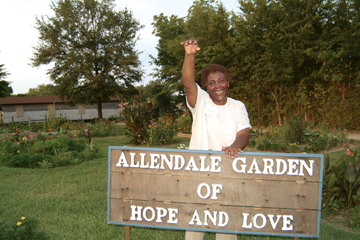
Imagine a neighborhood where you know something about
almost everyone. Where, (if you lived in the Shreveport,
La., Allendale neighborhood) you know Rosie Chaffold (left).
She's the 72-year-old grandmother who turned a drug-heavy
corner into the neighborhood garden. And since you know
Rosie, you know just about everybody else. 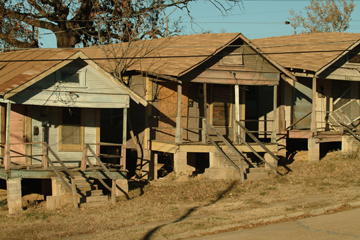
Rosie is only one of many in this 10-block area who
seem to know everyone; the ones who somehow tie the whole
community together. Yet 10 years ago this small, poverty-ridden
enclave -- punctuated by decrepit 1930s-era row houses
- was the kind of neighborhood taxis refused to visit.
That was before Mack's idea changed everything.
History Doesn't Have to Repeat
Historian Arnold Toynbee identified 33 major civilizations.
He noted that throughout human history, civilizations
have developed, declined, decayed and collapsed. Thirty-two
are gone; we are living in the 33rd -- the Western European
civilization, the first to spread worldwide. But we do
not have to repeat history. "Civilizations die from suicide,
not by murder," Toynbee said.
McCarter is a student of Toynbee. And Lewis Mumford,
the respected social analyst who wrote extensively about
civilization. But the man McCarter "walked with" physically
and spiritually for 17 years, was D. Elton Trueblood,
the 20th century author, educator, philosopher and theologian
who taught that society needs a broadly based ecumenical
"fellowship of the committed."
Trueblood and the others sparked a refrain in McCarter's
head as he sought solutions for social disintegration:
Only the village has never failed.
Myriad models have come and gone, but the village has
remained constant. Why? Because it's based on a system
of relationships, he realized. Close and personal relationships.
The sort that allow minds to come together to make good
things happen.
Being the save-the-world sort that he is, McCarter's
mind moved to recreating the village within our cities
in a systematic, methodical way. He has spent decades
just thinking about it and 12 years refining the model,
but the end product looks promising.
"Our thesis was this: All society
is a system of relationships -- it has a relational foundation.
We call that foundation social capital. It is a measure
of how people are connected together," McCarter said,
characteristically passing on credit by including just
about everyone he knows (which is a lot of people), for
the 1994 launch of the program he now heads -- Shreveport-Bossier
Community Renewal.
His thesis, at its most basic, asks, How many people
do you know and care about? And how many people do they
know and care about?
Today that thesis is a thriving model of community renewal
in Louisiana that is quietly exploding onto the world's
stage. With the creation last fall of Africa Community
Renewal in Cameroon and the spring announcement of the
birth of Greater New Orleans Community Renewal, McCarter's
idea is achieving what he hoped -- being embraced by nearly
everyone who encounters it.
Shreveport-Bossier Community Renewal (SBCR), which has
a $2.5 million annual operating budget and 29 employees,
involves nearly 18,000 residents, not including a host
of volunteers from universities and communities around
the country who come to learn. Eight neighborhood centers,
known as Friendship Houses, have injected hope into six
Shreveport communities. In the past four years, the program
has spread to Austin; Abilene; Baton Rouge, La.; Knoxville,
Tenn.; five villages in Cameroon, Africa; and now New
Orleans.
A city-block-sized National Center for Community Renewal,
which will be the city's first environmentally friendly
"green" building, is under development in downtown Shreveport.
When finished, community leaders from around the world
will come for training and certification in community
renewal.
A partnership with Infopoverty, a communications technology
program in a charter office within the United Nations,
was signed this year designating SBCR a community-building
model for the world. At an international Infopoverty
conference on the New Village at the U.N. in April, it
was announced that a remote community in Cameroon will
be the inaugural site for the merging of Infopoverty's
communications technology and McCarter's social technology.
Since 1996 more than $6 million in personnel, programs
and capital has flooded Shreveport-Bossier's most needy
neighborhoods. A partnership with the Fuller Center
for Housing, run by Habitat for Humanity founder Millard
Fuller, is bringing a sea of volunteers from around the
country to build 60 homes for Katrina evacuees in the
Allendale neighborhood. Corporate partners like 84 Lumber
and Jeldwen donated truckloads of building materials
for a Friendship House in the Queensboro Neighborhood.
City officials are on board, as are pastors, service
organizations and other nonprofits. The program has been
recognized by the Pew Partnership for Civic Change as
being a "Solution for America," and the Manhattan Institute
for Policy Research gave SBCR its Social Entrepreneurship
Award in 2005. Last year the John F. Kennedy School of
Government at Harvard University produced a comprehensive
case study on SBCR, giving it the seal of approval.
Pretty good showing for such a simple idea.
Not Just Another Program
McCarter is fond of analogies. He likens community renewal
to cleaning a dirty swimming pool -- we can't clean it
one cup at a time; we need an industrial filter.
To fix a disintegrating society, he said, a similar
system is needed -- one that can pull entire communities
through a "filter" that will systematically develop relationships
across every strata.
"Friendship is the most powerful force of transformation
in the universe and the agent through which power is
transferred and appropriated," he said. "So we're measurably,
concretely, scientifically and methodically growing this
foundation by building friendships."
Sometimes the naturally optimistic McCarter sounds more
like a professor than the former preacher that he is,
but not when he's out making friends. And certainly not
in 1991 when he and wife Judy Keator McCarter '67 left
the Texas congregation he led and moved (with three years
of financial backing from a friend) to their hometown
of Shreveport, to see if his long-percolating "solution"
would work in the real world.
Today he admits he was terrified the first time he stepped
into the dangerous Allendale neighborhood and knocked
on a door. "Hi, I'm Mack McCarter, and I'm here to be
your friend," he announced to the startled resident.
He went back to Allendale every Saturday morning at 10:30
for months and knocked on doors. Eventually, people began
to wait for him on their porches.
"It was an astonishing transformation for me," he recalled.
"I was set free by being a friend. And I realized, What
if we can do this where we live, too?"
That moment was the dawning of McCarter's revolution
against "societal breakdown."
"Of the 300,000 people in Shreveport-Bossier, about
1,000 want to hurt each other. The rest want to help
each other," he noted. "Overwhelmingly, our base is made
up of people who care for other people. But the city
can still collapse, because the key is not individual
acts of caring; the key is connecting caring people.
"This is the reality of every city in the world. The
vast majority are caring. But we are invisible to each
other."
So, McCarter reasons, practicing intentional acts to
develop friendships can connect caring people.
"We are here to make visible what is already there,"
he said of SBCR. "Then we help in the connection."
One. Two. Three.
The organizational side of SBCR consists of three components:
the We Care Team, Haven Houses and Friendship Houses.
The first level, the We Care Team, is more than 16,000
strong in Shreveport-Bossier. Residents simply fill out
a card and identify themselves as "a caring person."
They get a small We Care button and sticker for their
car. They are now a visible part of the caring majority.
SBCR hopes to have 50,000 signed up by 2007.
Haven House utilizes volunteer block leaders who agree
to spend one hour, three weeks a month getting to know
the people on their block. They get a wooden We Care
sign to put out front. Several times a year the Haven
House leaders meet to chat and swap ideas. Shreveport
now sports nearly 700 signs in yards representing both
ends of the economic strata and everything between.
Wade Shemwell is a Haven House leader. Until he got
involved, he said he felt alone in the neighborhood he
grew up in. "I could come and go, and I saw people and
never knew their names. My neighbors later said they
had the same feeling. It was almost like we thought we
needed permission to go out and meet each other."
Now the sense of isolation is gone. "I definitely feel
safer in my neighborhood because I know that we each
care for each other and look out for each other," he
said. "When I walk through the neighborhood with my dog,
Cody, people know what my name is, and we stop and talk
like old friends."
Friendship Houses, also known as "Internal Care Units"
or ICUs, are probably the most dramatic aspect of the
program and certainly require the greatest resources.
But that also raises the rewards. 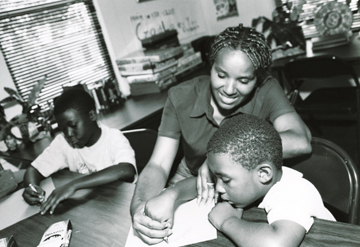
Two of SBCR's eight Friendship Houses are in Allendale,
and they are the center of the 10-block community. A
colorful playground rests beside one. Each is home to
a family hired by SBCR to be ambassadors to the community.
They live in half of the first floor. A large community
room fills the other half of the house. With a
small kitchen and half-bath, the spacious area is occupied
daily by teens, children and adults from the neighborhood.
After-school programs, adult education classes and friendly
visits from church groups, health care workers, firemen
and police keep the lights on long into the night.
McCarter compares the Friendship Houses to a landing
pad -- a place for service organizations to connect with
those who need help.
"We train and send families in the neighborhood to build
MERs (mutually enhancing relationships)," he said. "We
first have to win trust, so we start by serving the children
and youth. Eventually those relationships are transformed
into a means for a massive delivery system to begin to
occur."
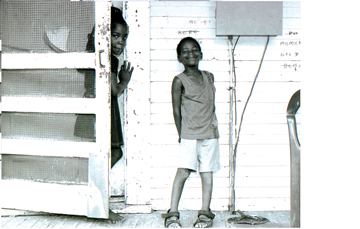 Shreveport has the nation's highest infant mortality
rate. Forty percent of the residents are under served
medically -- sometimes because they don't know how to
get to a doctor. And, until now, health care workers
didn't know how to get into the impoverished neighborhoods. Shreveport has the nation's highest infant mortality
rate. Forty percent of the residents are under served
medically -- sometimes because they don't know how to
get to a doctor. And, until now, health care workers
didn't know how to get into the impoverished neighborhoods.
"Now they have a place to land -- at our Friendship Houses,"
McCarter said. "We are the intercession. We hook the
two ends together."
The Friendship House is the town square -- the place
where people come together to solve problems and, well,
to care for each other. When that happens, caring acts
tend to grow exponentially and everyone is better for
it. Just like in a village.
Shreveport Mayor Keith Hightower is amazed by what's
happened in his city.
"We've seen the crime rates change dramatically," he
said. "If a group had come into one of these neighborhoods
10 years ago and left the lumber for a house out overnight,
it might not be there in the morning. But there's such
respect now from the neighbors that when one of these
is going up, they are the security guards. There are
no problems."
It's been good to have a group outside the government
do the heavy lifting, Hightower said. "Mack's been able
to rally the neighbors, rally the churches, rally the
community groups to get something done. And he's done
it in neighborhood after neighborhood.
"It's a new model not only for this community, but hopefully
for the country and possibly the world."
Brothers
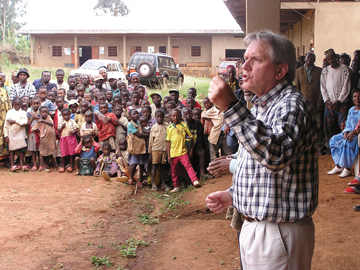 A continent away, five African chiefs, representing
150,000 people worldwide, are building a We Care Team.
Haven House leaders soon will be trained, and plans for
a Friendship House are underway. A continent away, five African chiefs, representing
150,000 people worldwide, are building a We Care Team.
Haven House leaders soon will be trained, and plans for
a Friendship House are underway.
In April the chiefs spent a week in Louisiana, seeing
how the program works. Allendale threw a block party,
complete with music and dancing and an abundance of food,
which drew more than 300 residents.
Through a translator, Chief Ngatsi C?lestin, speaking
for all five chiefs, told those gathered they are now
"brother and sister."
"We are in your community because you and we now form
one family," he said to loud applause. "We believe in
friendship. We believe in the community of people, and
we believe in a world where life is better for every
human being."
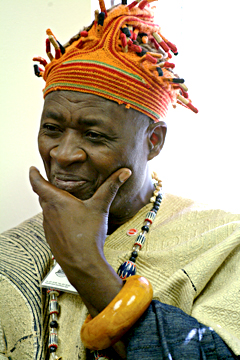 Ngatsi, leader of the Bawouwoua tribe, said in a deep,
purposeful voice that his people now call their five
villages Doumbouo, which in their traditional language
means a meeting place; where people come together. Ngatsi, leader of the Bawouwoua tribe, said in a deep,
purposeful voice that his people now call their five
villages Doumbouo, which in their traditional language
means a meeting place; where people come together.
"It's a place to think about solutions for the community,
to share our joy and our sorrow," he said. "We have the
same objectives as you, and that's why we believe the
model of community renewal here in Shreveport can be
replicated in our community. Our population is ready
to make this happen over there."
It's a population rich in history and ritual born centuries
ago. In Duombouo, a chief is the keeper of tradition
and, as such, is most revered. Valentin Miafo-Donfack,
a member of one of the tribes and SBCR's director of
international relations, said that when the chiefs boarded
the plane in the capital city, Yaoundi, 10,000 people
came to see them off. The majority traveled more than
300 miles to be there.
On the plane, the chiefs carried a traditional gift
for the residents of Allendale. During his speech at
the block party, Ngatsi held up a switch of leaves hanging
on a stalk. The roots drooped below. 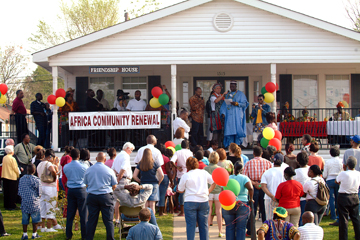
"We the five chiefs of Duombouo, on behalf of the entire
community of Duombouo, would like to plant in Shreveport
this plant," he said. "In our tradition, this is the
tree of peace. It is a symbol of love and a symbol of
peace. We would like to see this grow in Shreveport and
extend its peace throughout the world."
He then walked down the steps and poked a hole in a
small garden with his elaborately carved chieftain's
staff. In it he placed the Peace Plant, and two children
packed dirt around. Someone poured a bottle of water
on it.
Ngatsi said this tree never dies.
ALBERT SCHWEITZER said the more moral a man is, the
more sophisticated he is, not the more tools he has. McCarter
says we've been measuring society by the advance of technology,
not by the advance of humanity.
"We need to have skills to live together," he said.
"And we need to understand those skills, measure those
skills and grow those skills."
As McCarter watched the Allendale neighbors crowd around
the chiefs, he noted that even though there are millions
of caring people, we haven't figured out how to stop
the disintegration.
"You have to connect caring people," he said. "That's
the critical equation."
Comment at tcumagazine@tcu.edu
Out of Africa
 Last spring, McCarter and three others spent a week in Cameroon sharing their vision and establishing Africa Community Renewal. One village member, Valentin Miafo-Donfack, who interned with SBCR while working on a master’s degree in non-profit administration at Centenary College in Shreveport, had excitedly talked to his chief about this American program that could help his people too. An invitation was issued. Last spring, McCarter and three others spent a week in Cameroon sharing their vision and establishing Africa Community Renewal. One village member, Valentin Miafo-Donfack, who interned with SBCR while working on a master’s degree in non-profit administration at Centenary College in Shreveport, had excitedly talked to his chief about this American program that could help his people too. An invitation was issued.
During the trip to Africa, McCarter was designated by five chiefs, leaders of smaller tribes within the Bamileke Tribe as an official African American and honorary chief; a brother. More important, while there, the groundwork for Africa Community Renewal was laid.
Last August, the first We Care pins were awarded personally by the chiefs. But not to just anyone. Potential Renewal Team members need to find two others who will vouch for them as caring individuals. It’s an adaptation of the program Chief Fossokeng Solefack II Simon, of the Batseng’la tribe, said suits their particular needs.
“It is important that you be very conscious of what you are doing,” he said. “Just giving you a button won’t make a difference if you don’t understand the significance.”
Valentin Miafo-Donfack, the U.S. director of Africa Community Renewal, said that his people are now focused on what is good for the community, not what divides them. As they sign up the Renewal Team and begin to train Haven House leaders, they have a common goal in sight: A friendship house in their midst. “That way if someone wants to come to Africa to help, there is a place to come,” he said.
Isolated in a remote corner of the country, most in this community of subsistence farmers live in mud brick homes. Water comes from creeks. What electricity they get is sporadic. The young have to leave the womb of the village to find education and jobs. They see community renewal as the foundation to solving all these problems, Miafo-Donfack said.
“The important thing is the idea of community mobilization,” Miafo-Donfack said. “Bringing everyone together around a project is more powerful than just one group or one person doing something in one area. The community coming together as one person is a more powerful way of doing things.”
For information on the Bamileke: www.lafaba-dfw.org/bamileke_index.html
National Center
Mack McCarter often notes that while we know how to renew a building, we “stand like Neanderthals” before our decaying communities. Ironically, his group is now tackling a building too — the 16-story Petroleum Tower in downtown Shreveport that was donated in 2001 to Shreveport-Bossier Community Renewal. The once-prosperous building has lain dormant for more than a decade.
When reconstruction is complete in two or three years, the entire city block will be transformed into a National Center for Community Renewal that will host individuals and groups from around the world, and house a think tank that will examine and develop social technology.
It’s a $62 million collaboration between government, private industry and universities that will transform — and jump-start — the renewal of the downtown business district. As well as become an international launching pad for community renewal.
“This will be a teaching hospital, where people come and learn the philosophies, concepts and methodology of SBCR,” McCarter said. “Those who come will be immersed in the practicum and certified in the community renewal model.”
Already the project is helping the community — 50 hurricane evacuees and local workers are being trained at Southern University-Shreveport in general construction, asbestos removal, bioremediation and hazardous materials; skills which will allow their employment at the Petroleum Tower now and, later, throughout the state's massive recovery effort.
Remarkably, the building itself sends a message about sustainable communities — when complete, it will be the first platinum certified ‘green’ building in the state. That means the state-of-the-art, toxin-free building will produce its own energy and recycle its wastewater.
“The greatest need facing us in the 21st century is to build a renewal industry,” McCarter said. “The construction of this “green” building is a major step in the right direction.”
|



